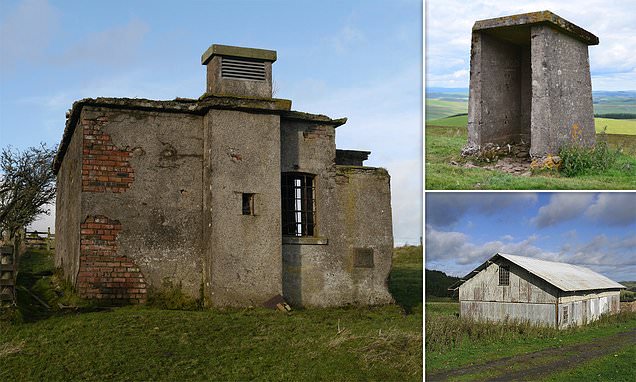Last surviving UK prisoner of war camp where Germans were held in First World War is recognised as site of national importance
- Stobbs Camp in Hawick, Scotland held German citizens from 1914 to 1918
- Parts of the camp now scheduled monuments by Historic Environment Scotland
The UK’s only surviving prisoner of war camp that held thousands of German soldiers and citizens during the First World War has been recognised as a site of national importance.
Stobbs Camp in Hawick, Scotland was home to prisoners of war from 1914 to 1918 and also held German citizens who had been rounded up by authorities.
Parts of the camp, which has been immaculately preserved, have now been confirmed as scheduled monuments by Historic Environment Scotland.
After being bought by the War Office in 1902, Stobbs Camp began an army training centre and at one point it’s 20,000 strong population outnumbered the nearby town of Hawick itself.
The camp included training trenches and firing ranges and tracked target range for tanks dating back to World War Two.

The UK’s only surviving prisoner of war camp is set to recognised as a site of national importance

Stobbs Camp is located in the Scottish borders near Hawick

During the First World War the camp held captured German soldiers and citizens
In 1914 when war in Europe broke out the base’s purpose shifted slightly and it became a prisoner of war camp.
Initially it was mostly home to non-fighting Germans who were in the UK at the time war broke out in Europe.
Indeed just 3,100 of the 13,600 internees held in Britain on 22 September, 1914 were actually soldiers.
By February 1916, this had changed with official records stating that Stobs housed 4,616 prisoners, of whom 1,829 were soldiers, 504 sailors and 2,283 civilians.
At its peak the camp was a hugely impressive structure built up of a large compound encircled by barbed wire with sentry posts.
Inside four compounds known as A,B,C and D were closed off from each other by fences.
Each individual camp had its own exercise yard where prisoners would be allowed to socialise.
The public consultation received 90 replies with the majority in favour of the move which will help safeguard the site.

Initially it was mostly home to non-fighting Germans who were in the UK at the time war broke out in Europe

At its peak in the latter stages of the conflict the camp held thousands of prisoners of war
Dara Parsons, Head of Designations at HES, said: ‘Stobs Camp is an outstanding monument to Scotland’s role in the two great conflicts of the 20th century.
‘It gives us a unique insight into the experience of those involved in these conflicts; those that served in the British military, civilian internees and prisoners of war.
‘We’re delighted to have had such a positive response to our proposal.
‘Designating a site as a scheduled monument helps to recognise what is most special and ensures that significance informs long-term management for future generations.’
Dianne Swift, Development Manager at Archaeology Scotland, said: ‘Since 2016 Archaeology Scotland have supported investigation and learning about Stobs Camp with members of both local and global communities.
‘Its designation as a scheduled monument will help raise awareness of the important work they have delivered and ensure the stories relating to Stobs Camp are more widely known.’
Source: Read Full Article


